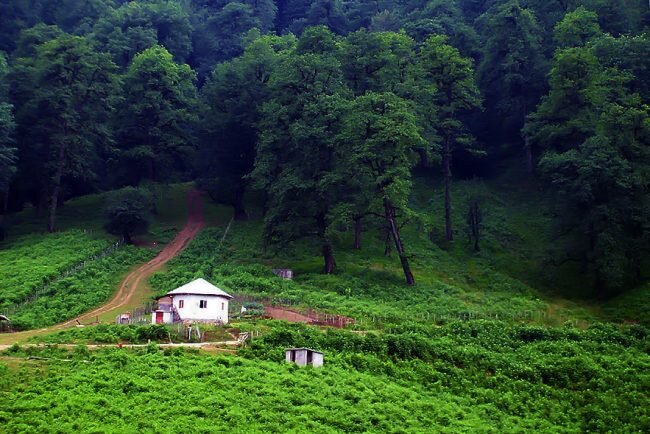Northern forests save 3.6bcm of water annually in Iran

TEHRAN – The forests of northern Iran save 3.6 billion cubic meters of water annually, playing an important role in preserving the aquifers.
Apart from physical care of natural resources, biological protection of these resources is also on the agenda of the Forests, Rangelands, and Watershed Management Organization (FRWMO), Abbas-Ali Nobakht, deputy head of FRWMO, said on Wednesday.
In this regard, development, rehabilitation, and enrichment operations in more than 232,000 hectares of rangeland, desert and forest lands of the country are underway, he added.
Referring to the northern forests of the country, especially Golestan province, as the reserves of the rarest plant species, Nobakht noted that the importance of these natural resources is so high that some European countries requested to receive seeds of plant species of northern Iran.
Rich biodiversity of Iranian ecoregions
The great difference between the two latitudes of the north and south of the country and the existence of different plains, altitudes, and climates have given a very diverse view to the vast land so that a variety of vegetation and plant species are grown across it.
The Hyrcanian ecological zone covers the green belt, the southern margin of the Caspian Sea, and the northern profile of the Alborz mountain range. The forested areas of the region stretch to 2.4 million hectares covering Astara in Gilan province to Glidaghi in Golestan province.
Due to soil fertility, temperature changes, and numerous rainfalls, this ecological area is rich in plant species, so that more than 80 species of broadleaf trees, 4 species of conifers, and 50 species of shrubs have been identified so far, most of which are beech, hornbeam, oak, maple, and alder.
The forests of this region, as an intact and healthy generation, form a belt of deciduous trees of the third geological period. These forests, which are called wet or Caspian forests, have high environmental and economic values, which are considered as world natural heritage.
The area of forests in the Iran-Turani ecological region, which covers most of the central plateau of Iran, is 4,666,941 hectares. Based on topographic and altitude conditions, this region is divided into two mountainous regions with a cold climate and a desert with a hot and dry climate.
Although the climatic conditions of the region have caused the dispersal and distance of trees, due to its vastness, a variety of plant species constituting 69 percent of the total flora of Iran is located in this area.
The main species of the mountainous region are Persian turpentine, almond, and juniper and the main species of the plain region are genus Tamarix, Haloxylon, Zygophyllum, and Calligonum.
Arasbaran forests, which are among the semi-humid forests of the country, are located in the province of East Azarbaijan and northwest of Ardebil province, which covers 174,838 hectares.
Arasbaran forests have been protected by UNESCO since 1976 as one of the biospheres reserves due to their rare and unique plant species and rich biodiversity. A variety of plant species is a special feature of this vegetation area; as over 775 plant species have been identified in the protected area alone, 55 of which have been reported for the first time in Iran.
There are many forest species in the Hyrcanian vegetation area. However, the main species of beech and alder have not grown in Arasbaran, which has caused this area to be separated from the Hyrcanian ecological area in the divisions.
The main flora species of the Arasbaran region are water oak, white oak, common hornbeam, English yew, and maple.
Some sources date the Zagros oak forests to 5,500 years. The creation and expansion of these forests are due to rainfall raised by the Mediterranean system and the Black Sea, which extends from the Sardasht area of West Azarbaijan to Firoozabad city of Fars province covering an area of 5,440,494 hectares.
One of the criteria for determining the border of this area is its dominant plant species, Quercus persica. But the area also grows the main species of Persian turpentine, almond, Acer monspessulanum, and wild pear.
Two important functions of Zagros oak forests are water and soil protection, which are of undeniable importance due to the predominant arid and semi-arid climate in the country, as any kind of conservation and rehabilitation investment is justified. Zagros forests are considered protected forests due to their limited growth.
Iran suffering water scarcity
Iran is an arid and semiarid country with scarce and sensitive water resources and the increasing demand for water has led to an alarming decrease in annual per capita renewable water resources. Due to the fact that available water resources are unevenly distributed in terms of both time and space, water resources in many areas are under pressure.
The reasons behind the present shortage of water for urban and domestic uses are the uneven distribution of water across the country, the expansion of population centers as well as developments in unsustainable agricultural and industrial activities.
Iran has an average annual precipitation of about 250 mm; less than one-third of the world average.
Mohammad Reza Goldansaz, a researcher in the field of water resources, said in June 2019 that an annual amount of 50 billion cubic meters of groundwater resources are withdrawn to supply agricultural, industrial as well as drinking water in Iran.
In the past few years, water transfer projects have been proposed by the government to ensure water supplies for the provinces of Semnan and Sistan-Baluchestan suffering from severe water shortages, which need efficient water desalination systems.
FB/MG
